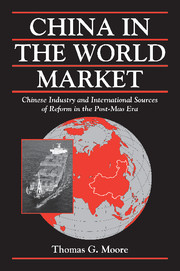Book contents
- Frontmatter
- Contents
- List of Figures
- List of Abbreviations
- Preface
- 1 China as a Latecomer in World Industrial Markets
- 2 The Outside World as an Impetus for Change in China
- 3 Tailor to the World: China's Emergence as a Global Power in Textiles
- 4 Beating the System with Industrial Restructuring: China's Response to the Multifiber Arrangement (MFA)
- 5 China Looms Large: Reform and Rationalization in the Textile Industry
- 6 Industrial Change in the Shadow of the MFA: The Role of Top-Level Strategy, Mid-Level Intervention, and Low-Level Demand in China's Textile Industry
- 7 Chinese Shipbuilding: The Modest Origins of an Emerging Industrial Giant
- 8 Dangerous Currents: Navigating Boom and Bust Cycles in International Shipbuilding
- 9 Chinese Shipbuilding and Global Surplus Capacity: Making a Virtue out of Necessity
- 10 Market-Oriented Solutions for Industrial Adjustment: The Changing Pattern of State Intervention in Chinese Shipbuilding
- 11 Who Did What to Whom?: Making Sense of the Reform Process in China's Shipbuilding Industry
- 12 External Shocks, State Capacity, and National Responses for Economic Adjustment: Explaining Industrial Change in China
- 13 China in the Contemporary International Political Economy
- Appendix Contours of the Research Effort
- Bibliography
- Index
11 - Who Did What to Whom?: Making Sense of the Reform Process in China's Shipbuilding Industry
Published online by Cambridge University Press: 07 August 2009
- Frontmatter
- Contents
- List of Figures
- List of Abbreviations
- Preface
- 1 China as a Latecomer in World Industrial Markets
- 2 The Outside World as an Impetus for Change in China
- 3 Tailor to the World: China's Emergence as a Global Power in Textiles
- 4 Beating the System with Industrial Restructuring: China's Response to the Multifiber Arrangement (MFA)
- 5 China Looms Large: Reform and Rationalization in the Textile Industry
- 6 Industrial Change in the Shadow of the MFA: The Role of Top-Level Strategy, Mid-Level Intervention, and Low-Level Demand in China's Textile Industry
- 7 Chinese Shipbuilding: The Modest Origins of an Emerging Industrial Giant
- 8 Dangerous Currents: Navigating Boom and Bust Cycles in International Shipbuilding
- 9 Chinese Shipbuilding and Global Surplus Capacity: Making a Virtue out of Necessity
- 10 Market-Oriented Solutions for Industrial Adjustment: The Changing Pattern of State Intervention in Chinese Shipbuilding
- 11 Who Did What to Whom?: Making Sense of the Reform Process in China's Shipbuilding Industry
- 12 External Shocks, State Capacity, and National Responses for Economic Adjustment: Explaining Industrial Change in China
- 13 China in the Contemporary International Political Economy
- Appendix Contours of the Research Effort
- Bibliography
- Index
Summary
EXPLAINING CHANGE IN THE SHIPBUILDING INDUSTRY: A CASE OF FOLLOWERS AND LEADERS?
Even if we accept that the international environment was a powerful influence in impelling certain changes in China's shipbuilding industry, we must still account for the response within China, just as we did with regard to the textile industry, and pose a similar set of questions. Did the reforms and other policy changes in the industry mainly reflect strategy made by the top leadership to cope with the exigencies of the world market in shipping and shipbuilding? Or were they fundamentally the result of bureaucratic intervention by CSSC Beijing? Or, finally, did the main impulse for change come from below as the yards reacted to changing market conditions at home and abroad? In other words, are the changes that occurred in the shipbuilding industry best conceptualized as the outcome of top-level strategy, mid-level intervention, or low-level demand?
Not surprisingly, actors at each level have tried to take credit for the success of the shipbuilding industry. For its part, CSSC Beijing has long maintained that it orchestrated reform in the industry, directing the yards to undertake various kinds of new responsibilities while simultaneously transforming its own role from a central decision-maker to a marketing agent and technical adviser. By contrast, the yards have claimed – rather predictably – that change was initiated largely from below, beginning with reforms taken at the unit-level. From this perspective, the yards led and CSSC Beijing followed.
- Type
- Chapter
- Information
- China in the World MarketChinese Industry and International Sources of Reform in the Post-Mao Era, pp. 258 - 275Publisher: Cambridge University PressPrint publication year: 2002



